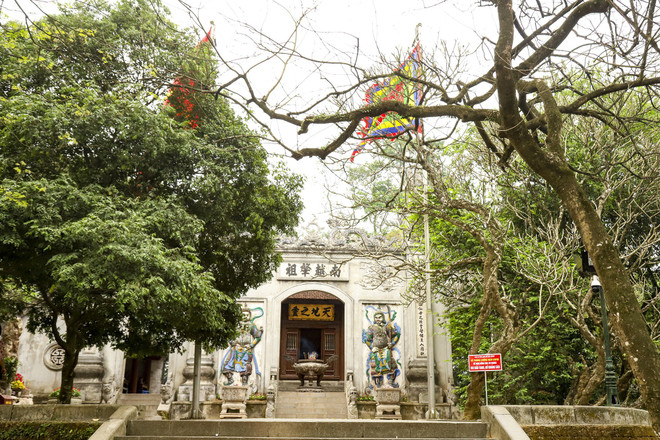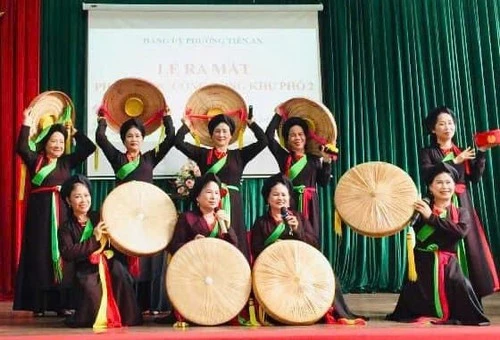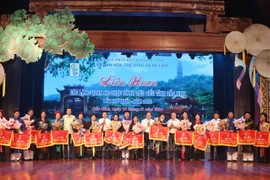Hanoi (VNA) – The United Nations Educational, Scientific and Cultural Organisation (UNESCO) has recently inscribed the Ba Chua Xu (Holy Mother of the Realm) Festival at Sam mountain in the Mekong Delta province of An Giang on the Representative List of the Intangible Cultural Heritage of Humanity, raising the total number of Vietnam’s such UNESCO-honoured intangible elements to 16.
They include Nha Nhac, Vietnamese court music; gong culture in the Central Highlands; Ca Tru singing; Quan Ho Bac Ninh folk songs; the Giong festival of Phu Dong and Soc temples; the Xoan singing of Phu Tho province; the worship of Hung Kings in Phu Tho; Don Ca Tai Tu (southern amateur music), Vi and Dam folk songs in Nghe Tinh; and tugging rituals and games.
Nha Nhac - Vietnamese court music
Having flourished under the Nguyen Dynasty (1802-1945), Nha Nhac means “elegant music” and refers to a broad range of musical and dance styles performed at the Vietnamese Royal Court from the 15th to the mid-20th century.
As a symbol of the dynasty’s power and longevity, Nha Nhac became an essential part of the court’s many ceremonies.
Nha Nhac was honoured as intangible cultural heritage of humanity by UNESCO in November 2003. According to the organisation, among the numerous musical genres that developed in Vietnam, only Nha Nhac can claim a nationwide scope.
Space of gong culture in Central Highlands
Inscribed in 2008 on the Representative List of the Intangible Cultural Heritage of Humanity (originally proclaimed in 2005), the cultural space of the gongs in the Central Highlands of Vietnam is closely linked to the daily life of local people. Their belief systems form a mystical world where the gongs produce a privileged language between men, divinities and the supernatural world.
Every family possesses at least one gong, which indicates the family's wealth, authority and prestige. While a range of brass instruments are used in the various ceremonies, the gong alone is present in all the rituals of community life.
Quan Ho Bac Ninh folk songs
Quan Ho is a form of folk singing characterised by a duet format. The male singers, known as "lien anh", wear traditional attire of folded scarves and "the" – shirts, while the female singers, known as "lien chi", don elegant dresses and round hats made from palm leaves with long silk straps. They sing together in pairs, delivering simple and soulful verses in a traditional style that does not require musical accompaniment yet remains melodious.
Quan Ho songs demonstrate the spirit, philosophy and local identity of the communities in this region and help forge social bonds within and between villages that share a cherished cultural practice. Quan Ho was recognised by UNESCO as an intangible cultural heritage element of humanity in 2009.
Ca Tru singing
Inscribed in 2009 on the List of Intangible Cultural Heritage in Need of Urgent Safeguarding, Ca Tru is a complex form of sung poetry found in the north of Vietnam using lyrics written in traditional Vietnamese poetic forms.
Ca Tru features a female singer accompanied by a small group of musicians. The art genre appeared in the North around the 15th century and thrived until the early 20th century.
Giong festival of Phu Dong and Soc temples
The Giong festival at Phu Dong and Soc temples in Hanoi is associated with the Saint Giong legend, a hero from Phu Dong village who defeated foreign invaders and brought peace to the country. Saint Giong symbolises the patriotic spirit of the Vietnamese people and is one of the four immortals deeply rooted in their spiritual life.
The Saint Giong Festival is held in Soc Temple, where the saint ascended to heaven, in the first lunar month and Phu Dong Temple, where he was born in the fourth lunar month.
In 2010, UNESCO recognised the Giong festival held at Phu Dong Temple and at Soc Temple in Hanoi’s Soc Son district as intangible cultural heritage of humanity.
Xoan singing of Phu Tho province
Xoan singing is a valuable intangible cultural heritage of the ancestal land of Phu Tho. This heritage has links to the worship of Hung Kings, a belief that originates from the Vietnamese practice of ancestor worship.
It is a type of traditional art performed during rituals and celebrations, comprising multiple elements of melodies, singing and dancing that serves the spiritual demands of the community.
On December 24, 2011, the Xoan singing in Phu Tho was officially recognised by UNESCO as intangible cultural heritage in need of urgent safeguarding. Then on December 8, 2017, it was added to the Representative List of the Intangible Cultural Heritage of Humanity.
Worship of Hung Kings in Phu Tho

For generations, the Vietnamese have considered the Hung Kings the lengendary founders of the country and the fathers of the nation. Every year, in the third month of the lunar calendar, Vietnamese people from far and wide gather in Phu Tho province to visit the Hung Kings Temple, pray for good weather and peace, and show their gratitude to the ancestors.
Worshiping Hung Vuong has become a cultural and religious symbol connecting the past with the present, helping to cultivate family, village and national sentiments. It was recognised as part of the Intangible Cultural Heritage of Humanity by UNESCO in 2012
Art of Don Ca Tai Tu (southern amateur music)
Considered one of the country’s main music genres, Don Ca Tai Tu originated from the Hue court music and folk music, and adapted on the basis of folk songs of the southern region. It came into being in late the 19th century, thrived in the early 20th century and remains an important part of the country’s traditional culture today.
The music is typically performed at festivals, commemoration rituals and celebrations by farmer-performers. Instrumentalists and singers express their feelings by improvising based on 20 principal and 72 classical songs. Don Ca Tai Tu was listed in the Representative List of the Intangible Cultural Heritage of Humanity in 2013 by UNESCO.
Vi and Giam folk songs of Nghe Tinh
Inscribed in 2014 on the Representative List of the Intangible Cultural Heritage of Humanity, Vi and Giam songs are sung by many communities in the north-central provinces of Nghe An and Ha Tinh.
Specific songs are sung without instrumental accompaniment while people cultivate rice in the fields, row boats, make conical hats or lull children to sleep.
Tugging rituals and games
Tug-of-war rituals and games are prevalent in the rice-farming cultures of East Asia and Southeast Asia as a form for communities to pray for abundant harvests and prosperity. They mark the start of the agricultural cycle and often begin with commemorative rites to local deities.
Tug-of-war rituals and games in Vietnam are practiced mostly in the midlands, the Red River Delta, and the north-central region, which are lands of longstanding Vietnamese settlement and the cradle of wet rice civilisation. In 2015, tug-of-war rituals and games in Vietnam, Cambodia, the Republic of Korea, and the Philippines were officially recognised by UNESCO as intangible cultural heritage of humanity.
Practices related to Vietnamese beliefs in the Mother Goddesses of Three Realms

Inscribed in 2016 on the Representative List of the Intangible Cultural Heritage of Humanity, the practices of the Mother Goddesses of Three Realms (heaven, water, and mountains and forests) aim to meet the spiritual needs and everyday wishes of Vietnamese people.
The traditional practice involves daily worship and participation in ceremonies, rituals like the spirit possession ritual and festivals at temples dedicated to the Mother Goddesses. These activities associated with the practice help to maintain part of the community's history, cultural heritage and identity, with some aspects incorporating traditional costumes, music and dance.
Art of Bai Choi in central Vietnam
Inscribed in 2017 on the Representative List of the Intangible Cultural Heritage of Humanity, the art of Bai Choi in central Vietnam is a diverse art combining music, poetry, acting, painting and literature.
The art of Bai Choi is a form of culture and recreation within village communities. It takes two main forms: Bai Choi games and Bai Choi performances. Bai Choi games involve a card game played in bamboo huts during the Lunar New Year. In Bai Choi performances, male and female artists perform on a sedge mat, moving from place to place or on private occasions for families.
Then practice of Tay, Nung, Thai ethnic people
The practice of Then is a form of folk art which combines a wide range of arts, such as literature, music, painting, dancing, painting and performance. It is an essential part of the spiritual life of the Tay, Nung and Thai ethnic groups, reflecting their concept of the connection between humans, the world and the universe.
It is performed during major celebrations of the new year, ploughing, and rituals wishing for safety, fortune, and good crops.
The practice of Then of Vietnam's ethnic groups of Tay, Nung, Thai was listed intangible cultural heritage of humanity on December 13, 2019.
Art of Xoe Thai dance
Xoe Thai is a unique type of traditional dance associated with and plays a significant role in the daily life of Thai ethnic communities in the northwest of Vietnam.
In the language of the Thai group, “xoe” means dance with movements representing people's activities during rituals, daily life and work. It is performed in various community activities, from festivals to funeral rituals. Performers are members of the Thai community, regardless of gender, age, job and social status. Dancers usually form a circle around a festive flame and move to the sound of traditional melodic music.
The art of Xoe Thai dance was recognised by UNESCO as intangible cultural heritage of humanity in December 2021.
Art of pottery-making by Cham ethnic people
Existing since late the 12th century, Bau Truc village in the south-central province of Ninh Thuan, is considered one of the very few ancient pottery villages in Southeast Asia that still retains the primitive production method from thousands of years ago.
Because they are made entirely by hand, Cham pottery products are unique. Each product reflects the style, craftsmanship, ingenuity, and even the emotions and moods of the craftsman during the process of making the product.
The making of pottery by the Cham people exudes a unique artistic value, preserving the fine customs and cultural identity of the Cham people in Vietnam.
On November 29, 2022, the art of pottery making by Cham ethnic people was officially recognised by UNESCO as part of the Representative List of the Intangible Cultural Heritage of Humanity.
Ba Chua Xu (Holy Mother of the Realm) Festival
The Ba Chua Xu (Holy Mother of the Realm) Festival on Sam Mountain is a traditional celebration that has been passed down through generations in Chau Doc city, in the southern province of An Giang.
Held from the 22nd to the 27th of the fourth lunar month, it reflects the culture of Vietnam’s southerners as well as cultural exchange and blending with the Khmer, Chinese, and Cham communities.
The festival honours Ba Chua Xu and serves as a time for local residents to express their gratitude and respect for those who have rendered service to the nation.
In December 2024, it became 16th intangible cultural heritage of Vietnam honoured by UNESCO./.




























